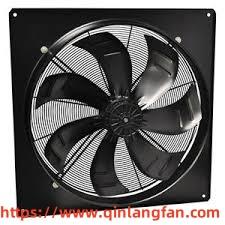Can Square Axial Fan Manufacturers and Qinlang Operate Reliably in High-Temperature Applications?

In industrial engineering, Square Axial Fan Manufacturers are increasingly guided by energy efficiency regulations that shape product design and operational standards. These standards require fans to maintain consistent airflow while minimizing power consumption, noise output, and environmental impact. Manufacturers must develop solutions that comply with strict codes without compromising performance or durability. Advanced blade geometry, optimized motor control, and improved material selection all contribute to meeting these requirements. Components are expected to operate reliably under high temperatures, fluctuating loads, and continuous cycles, reflecting a balance between innovation and compliance.
High-temperature applications present additional challenges for airflow systems. Fans often operate in furnaces, kilns, or manufacturing processes where ambient heat can compromise structural integrity. Materials must withstand thermal expansion, maintain dimensional stability, and resist oxidation or chemical corrosion. Engineers now design fans with heat-resistant alloys, reinforced composites, and advanced coatings to ensure long-term performance. Maintaining reliable operation under extreme conditions extends equipment life, reduces maintenance cycles, and preserves operational safety. This focus on resilience demonstrates how airflow systems have evolved beyond simple ventilation into engineered solutions capable of enduring harsh environments.
Energy regulations also drive innovation in monitoring and control. Fans increasingly incorporate sensors that measure temperature, rotation, and airflow, adjusting performance automatically to maintain compliance. This intelligent control reduces unnecessary energy use and ensures consistent operation even in demanding settings. Industrial managers can monitor system health remotely, predict maintenance needs, and optimize overall energy consumption. Such integration of smart technology with robust design creates a new standard for industrial airflow, combining reliability, efficiency, and adaptability in one solution.
Market demand reflects a convergence of regulation and operational needs. Facilities in chemical processing, power generation, electronics, and material production rely on fans that can withstand high temperatures while meeting strict energy efficiency criteria. Manufacturers who address both criteria gain access to broader markets, as compliance with local and international codes becomes a deciding factor for procurement. Fans must operate silently, efficiently, and reliably, even under constant stress. By meeting these dual requirements, manufacturers demonstrate technical expertise and an understanding of evolving industry standards.
Designing for high-temperature applications requires careful material selection and precision engineering. Blade shape, housing structure, and motor performance all influence thermal behavior. Fans must resist warping or fatigue caused by repeated heating and cooling cycles. Advanced alloys and ceramics are often used to maintain strength at elevated temperatures. Combined with efficient aerodynamic design, these materials allow airflow systems to deliver optimal cooling without excessive energy use. Regulatory compliance thus aligns with operational performance, creating fans that are both safe and efficient.
Maintenance considerations are equally important. High-temperature environments accelerate wear and can increase the frequency of servicing if components are not carefully engineered. Manufacturers design fans with modular parts, allowing for easy inspection and replacement without shutting down entire systems. This reduces downtime, supports continuous production, and ensures compliance with operational safety standards. The integration of intelligent monitoring tools further enhances reliability by detecting early signs of stress, vibration, or energy loss, providing actionable insights for industrial operators.
Sustainability and efficiency are increasingly intertwined. Fans that comply with energy regulations contribute to reduced carbon footprint, lower operational costs, and improved environmental responsibility. Industries benefit from systems that combine heat tolerance, structural durability, and intelligent control, creating long-term value. The ability to operate efficiently under extreme heat and strict regulations distinguishes leading manufacturers in a competitive market.
By addressing both regulatory compliance and high-temperature challenges, modern airflow systems demonstrate the evolving role of Square Axial Fan Manufacturers. Advanced materials, intelligent monitoring, and precision design create components capable of enduring rigorous industrial demands while maintaining efficiency and safety. These innovations reflect the intersection of environmental responsibility and technological advancement, offering solutions that support sustainable operations across multiple sectors.
Qinlang exemplifies this approach by delivering fans engineered to meet energy regulations while performing reliably in high-temperature environments. Its designs combine structural resilience, efficient airflow, and intelligent control, ensuring industrial applications operate safely and sustainably.visit https://www.qinlangfan.com/product/axial-fan/square-blinds-axial-fan/
- Art
- Causes
- Crafts
- Dance
- Drinks
- Film
- Fitness
- Food
- Games
- Gardening
- Health
- Home
- Literature
- Music
- Networking
- Other
- Party
- Religion
- Shopping
- Sports
- Theater
- Wellness


